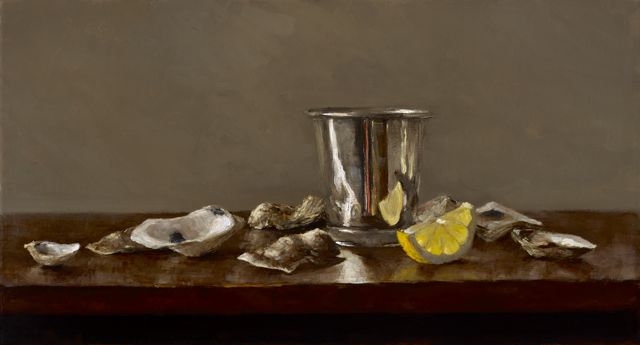The word “silverware” is seldom used in reference to real silver. Instead, it’s typically applied to household utensils that are silver-plated at best but more likely to be made of stainless steel, aluminum or even plastic.
Still, the word does have legitimate roots in both the American home and the decorative arts. And nearly two centuries of that artistic and cultural lineage are on view in condensed form in Farm to Table: American Silver, an exhibit opening Saturday, May 31, at the Asheville Art Museum.
Curated by museum staffer Luiza deCamargo, Farm to Table traces both the practical and the purely aesthetic evolution of food-based American silver, as well as the periodic technical jumps in silversmithing. Works range from cups, ewers and trophies awarded at early 19th-century agricultural competitions to individual Tiffany ladles and full-service flatware sets from turn-of-the-century, postwar and contemporary American tables.
The show’s oldest pieces are a group of julep cups, called beakers in regions unfamiliar with the beverage. One is engraved “1836 Bourbon County Agricultural Society Premium.” The cups are cast in coin silver, a type of metal often literally made by melting down domestic and foreign silver coinage. Each is roughly 90 percent silver with 10 percent copper added for strength — the same breakdown used in American silver coins until 1964.
The exhibit explores silver’s cultural and material evolution. “Silver has always been a luxury good. But the decorative arts allow us explore the context of this art,” notes deCamargo. “By studying silver, we can learn about raw material, process, technology and taste as well as the makers, buyers and users.”
For centuries, silver was available only to the prosperous. But a series of ore finds in the American West (such as the 1859 discovery of the Comstock Lode in Nevada’s Virginia Range) and the advent of silver plating and filling techniques made silverware accessible to a broader audience. This was particularly true after the turn of the last century, when whole wedding sets could be mass-ordered from catalogs.
These advances also encouraged stylistic proliferation. The show’s flamboyantly ornamental peak hits shortly after the sterling standard of the 1870s was established. Ladles, pie servers and gargantuan trays are decorated with rich floral and garden patterns. Mere decades later, works exhibit art nouveau flourishes and arts and crafts stylings before transitioning into the geometric forms of 1920s art deco. Each style places the craft and the crafter in their time.
The exhibit also features a series of food-and-ag-oriented paintings, prints and drawings that provide an atmospheric backdrop for the silver.
“Oysters and Silver,” an oil still life by contemporary Pennsylvania-based painter Sarah Lamb, depicts the detritus of a light yet indulgent meal: a lemon wedge and shucked oyster shells surrounding a polished julep cup.
“Ruby,” a small 1830s oil painting of a prize-winning cow, is positioned near an 1837 julep cup engraved with the same name. Each work revels in its own midcentury glory. But what makes those stories even better: They’re both honoring the same cow.
“Farm to Table: American Silver” is on view at the Asheville Art Museum through Sunday, Oct. 5. An opening reception will be held Friday, June 6, 5-8 p.m. During the event, local potters and glass artists will create a variety of drinking vessels, which will be available for purchase. For more information, visit ashevilleart.org.




Before you comment
The comments section is here to provide a platform for civil dialogue on the issues we face together as a local community. Xpress is committed to offering this platform for all voices, but when the tone of the discussion gets nasty or strays off topic, we believe many people choose not to participate. Xpress editors are determined to moderate comments to ensure a constructive interchange is maintained. All comments judged not to be in keeping with the spirit of civil discourse will be removed and repeat violators will be banned. See here for our terms of service. Thank you for being part of this effort to promote respectful discussion.